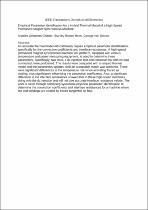 ResearchSpace
ResearchSpace
Empirical parameter identification for a hybrid thermal model of a high-speed permanent magnet synchronous machine
JavaScript is disabled for your browser. Some features of this site may not work without it.
- ResearchSpace
- →
- Research Publications/Outputs
- →
- Journal Articles
- →
- View Item
| dc.contributor.author |
Grobler, AJ

|
|
| dc.contributor.author |
Holm, Stanley R

|
|
| dc.contributor.author |
Van Schoor, G

|
|
| dc.date.accessioned | 2019-02-27T09:49:09Z | |
| dc.date.available | 2019-02-27T09:49:09Z | |
| dc.date.issued | 2017 | |
| dc.identifier.citation | Grobler, A.J., Holm, S.R. and Van Schoor, G. 2017. Empirical parameter identification for a hybrid thermal model of a high-speed permanent magnet synchronous machine. IEEE Transactions on Industrial Electronics, v 65(2), pp 1616-1625 | en_US |
| dc.identifier.issn | 0278-0046 | |
| dc.identifier.uri | http://ieeexplore.ieee.org/document/7997754/ | |
| dc.identifier.uri | http://hdl.handle.net/10204/10734 | |
| dc.description | Copyright: 2017 IEEE. Due to copyright restrictions, the attached PDF file only contains the abstract of the full text item. For access to the full text item, kindly consult the publisher's website. | en_US |
| dc.description.abstract | An accurate thermal model will commonly require empirical parameter identification, specifically for the convection coefficients and interface resistances. A high-speed permanent magnet synchronous machine test platform, equipped with various temperature and power measuring equipment, is used to determine these parameters. Specifically, two tests, a dc injection test and rotational test with no load connected, were performed. The results were compared with a lumped thermal model and the parameters updated until an acceptable match was achieved. There were significant differences in the temperature rise when activating forced air cooling, thus significantly influencing the convection coefficients. Also, a significant difference in the interface resistances showed that in these high-speed machines, doing only the dc injection test will not give accurate interface resistance values. The work is novel through combining systematic empirical parameter identification to determine the convection coefficients and interface resistances for a machine where the end windings are cooled by forced tangential air flow. | en_US |
| dc.language.iso | en | en_US |
| dc.publisher | IEEE | en_US |
| dc.relation.ispartofseries | Worklist;19940 | |
| dc.subject | Temperature measurement | en_US |
| dc.subject | Stator windings | en_US |
| dc.subject | Thermal resistance | en_US |
| dc.subject | Temperature sensors | en_US |
| dc.subject | Windings | en_US |
| dc.subject | Convection | en_US |
| dc.title | Empirical parameter identification for a hybrid thermal model of a high-speed permanent magnet synchronous machine | en_US |
| dc.type | Article | en_US |
| dc.identifier.apacitation | Grobler, A., Holm, S. R., & Van Schoor, G. (201). Empirical parameter identification for a hybrid thermal model of a high-speed permanent magnet synchronous machine. http://hdl.handle.net/10204/10734 | en_ZA |
| dc.identifier.chicagocitation | Grobler, AJ, Stanley R Holm, and G Van Schoor "Empirical parameter identification for a hybrid thermal model of a high-speed permanent magnet synchronous machine." (201) http://hdl.handle.net/10204/10734 | en_ZA |
| dc.identifier.vancouvercitation | Grobler A, Holm SR, Van Schoor G. Empirical parameter identification for a hybrid thermal model of a high-speed permanent magnet synchronous machine. 201; http://hdl.handle.net/10204/10734. | en_ZA |
| dc.identifier.ris | TY - Article AU - Grobler, AJ AU - Holm, Stanley R AU - Van Schoor, G AB - An accurate thermal model will commonly require empirical parameter identification, specifically for the convection coefficients and interface resistances. A high-speed permanent magnet synchronous machine test platform, equipped with various temperature and power measuring equipment, is used to determine these parameters. Specifically, two tests, a dc injection test and rotational test with no load connected, were performed. The results were compared with a lumped thermal model and the parameters updated until an acceptable match was achieved. There were significant differences in the temperature rise when activating forced air cooling, thus significantly influencing the convection coefficients. Also, a significant difference in the interface resistances showed that in these high-speed machines, doing only the dc injection test will not give accurate interface resistance values. The work is novel through combining systematic empirical parameter identification to determine the convection coefficients and interface resistances for a machine where the end windings are cooled by forced tangential air flow. DA - 201 DB - ResearchSpace DP - CSIR KW - Temperature measurement KW - Stator windings KW - Thermal resistance KW - Temperature sensors KW - Windings KW - Convection LK - https://researchspace.csir.co.za PY - 201 SM - 0278-0046 T1 - Empirical parameter identification for a hybrid thermal model of a high-speed permanent magnet synchronous machine TI - Empirical parameter identification for a hybrid thermal model of a high-speed permanent magnet synchronous machine UR - http://hdl.handle.net/10204/10734 ER - | en_ZA |





